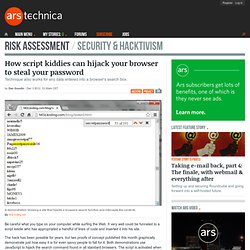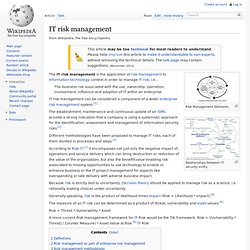

LookUps. THE SWORD.
How script kiddies can hijack your browser to steal your password. Be careful what you type on your computer while surfing the Web.

It very well could be funneled to a script kiddie who has appropriated a handful of lines of code and inserted it into his site. The hack has been possible for years, but two proofs of concept published this month graphically demonstrate just how easy it is for even savvy people to fall for it. Both demonstrations use JavaScript to hijack the search command found in all standard browsers.
The script is activated when a user presses the ctrl+f or ⌘+f keys, causing whatever is typed after that to be sent to a server under the control of the website operator rather than to the browser's search box. Proofs of concept here and here show how this method could be used to trick people into divulging their password or credit card number respectively.
To be sure, the demos are crude. More technical details about the exploits are here and here. There are at least two possible solutions to reduce threats like these. Pipl - People Search. Help Net Security. What is ITAR and EAR compliance. The International Traffic in Arms Regulations (ITAR) and the Export Administration Regulations (EAR) are two important United States export control laws that affect the manufacturing, sales and distribution of technology.

The legislation seeks to control access to specific types of technology and the associated data. Its goal is to prevent the disclosure or transfer of sensitive information to a foreign national. ITR contains a United States Munitions List (USML) of restricted articles and services. EAR contains a Commerce Control List (CCL) of regulated commercial items, including those items that have both commercial and military applications. To be ITAR or EAR compliant, a manufacturer or exporter whose articles or services appear on the USML or CCL lists must register with the U.S.
Export control laws provide for substantial penalties, both civil and criminal. Learn more: The U.S. IT risk management. Risk Management Elements Relationships between IT security entity The IT risk management is the application of risk management to Information technology context in order to manage IT risk, i.e.: The business risk associated with the use, ownership, operation, involvement, influence and adoption of IT within an enterprise IT risk management can be considered a component of a wider enterprise risk management system.[1] The establishment, maintenance and continuous update of an ISMS provide a strong indication that a company is using a systematic approach for the identification, assessment and management of information security risks.[2] Different methodologies have been proposed to manage IT risks, each of them divided in processes and steps.[3] Because risk is strictly tied to uncertainty, Decision theory should be applied to manage risk as a science, i.e. rationally making choices under uncertainty.

Exploits Database by Offensive Security. About malware and hacked sites - Webmaster Tools Help. Computer & Site Security. Exploits Database by Offensive Security. Risk assessment. Risk assessment is the determination of quantitative or qualitative value of risk related to a concrete situation and a recognized threat (also called hazard).

Quantitative risk assessment requires calculations of two components of risk (R):, the magnitude of the potential loss (L), and the probability (p) that the loss will occur. Acceptable risk is a risk that is understood and tolerated usually because the cost or difficulty of implementing an effective countermeasure for the associated vulnerability exceeds the expectation of loss.[1] In all types of engineering of complex systems sophisticated risk assessments are often made within Safety engineering and Reliability engineering when it concerns threats to life, environment or machine functioning. The nuclear, aerospace, oil, rail and military industries have a long history of dealing with risk assessment. Also, medical, hospital, social service[2] and food industries control risks and perform risk assessments on a continual basis.